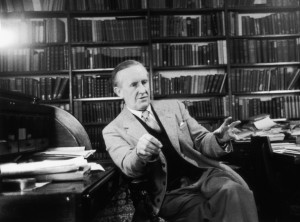 You might have seen this article when io9 debuted it last year, or you might not have. I missed it but it’s an interesting read. I spent a bit of time researching the Jeffrey Inaba artwork, which is called Skylight. The comparison to the Eye of Sauron (either book, or movie) seems inflated, but there are just a few parallels with the glow of the One Ring.
You might have seen this article when io9 debuted it last year, or you might not have. I missed it but it’s an interesting read. I spent a bit of time researching the Jeffrey Inaba artwork, which is called Skylight. The comparison to the Eye of Sauron (either book, or movie) seems inflated, but there are just a few parallels with the glow of the One Ring.
The author of The Hobbit and The Lord of the Rings casts a massive, sweeping shadow over fantasy literature and entertainment. But J.R.R. Tolkien’s influence spreads much further than that. Everywhere you look, you can see Tolkien’s legacy: in science, in art, in language.
Here are 10 fairly unlikely things that have been influenced or generated by the love of J.R.R. Tolkien. Some of these, you probably know about. Others might surprise you.
1) Contemporary Art
Danish artists Nina Beier and Marie Lund produced the obviously Tolkien inspired work “The Dedication (To J.R.R. Tolkein, To one who said that myths were lies and therefore worthless, even though breathed through silver)” a sculpture constructed out of two books, The Screwtape Letters by C.S. Lewis and Mythopoeia by J.R.R. Tolkien. Mythopoeia was a rebuttal to Lewis’ statement that myths were lies, defending myth-making as a way of expressing truths. Beier and Lund also explored the theme of myth-making with their exhibit “The Object Lessons” where they invited a curator to make a fictional text about a non-existent show, and they set out to create the show with actual objects — similar to the way Tolkien created a language and culture for his elves and dwarves, creating artifacts and history to support his mythological work. The pieces in the show seem very archaeological in nature.
Meanwhile, the foyer of the Stavanger Concert Hall in Norway boasts a giant Eye of Sauron. The piece by Jeffrey Inaba is formed by two joined rings that will reflect the natural lighting by day and glow by its own LEDs at night. The artist himself when pitching the project suggested the rings would attract visitors to the building as the magic ring from Tolkien’s world attracted people. But seriously, the glowing suspended circles have definitely got the “Eye of Sauron” thing going on.
Skylight by INABA from Inaba Inc on Vimeo.
2) Unicode
You might not have heard of Michael Everson, but he’s doing some really amazing work for language and technology. He’s a co-author of the Unicode Standard, and Contributing Editor and Irish National Representative to ISO/IEC JTC1/SC2/WG. And he’s done a lot of work with encoding minority languages into unicode, thus allowing people to use their own native languages on computers and in electronic formats. He also helps people like the Cherokee develop fonts for their languages. And Everson has also edited and written several dictionaries and primers of Middle English, along with Cornish, Breton and other languages.
In an interview on the Dork Forest podcast, he says his inspiration for his life’s work came from Tolkien. After hearing Nicol Williamson (Merlin from the movie Excalibur) read an abridged version of The Lord of the Rings, in middle school, he was set on fire. He read all of Tolkien and decided to be an Anglo-Saxon language professor, just like Tolkien. And luckily for the world, he expanded his linguistic interest. The interview is a fun listen. He is also currently in the process of trying to get Tolkien’s Tengwar, the elven script, and Cirth, dwarven runes, [Demosthenes: the Cirth was actually first an Elvish invention, but was enthusiastically adopted by the Dwarves of Moria and Erebor, who then developed their own “regional” variations) encoded into unicode. You know, just in case you need to write an email in either of those languages.


